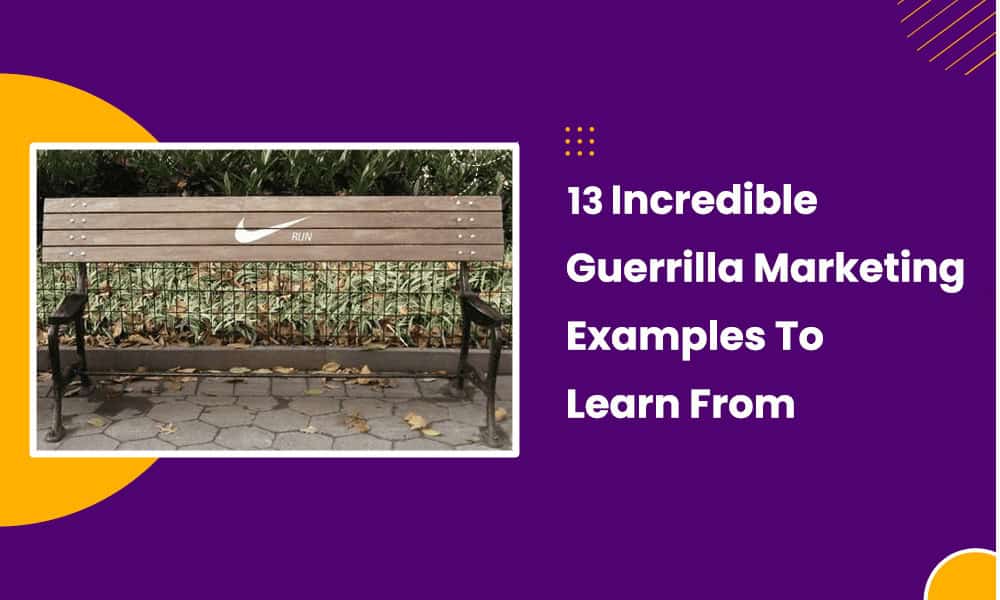Standing out with your marketing strategy in a world where advertisements galore can be an uphill battle. This is exactly where guerrilla marketing can help you by converting ordinary moments into unforgettable brand experiences.
And the best part? You won’t have to blow up your marketing budget to run a successful guerrilla marketing campaign. Guerrilla marketing creates an element of surprise, shock, or awe to build brand awareness and get consumers talking.
Moreover, recent studies indicate that over 88% of consumers trust product recommendations from people they know. If this is one of your goals, read on to get a breakdown of:
- Key elements of guerrilla marketing
- Real-life examples of guerrilla marketing
- Tips on brainstorming and implementing tactics
- Pitfalls you must avoid
- Measuring the success of your campaign
Let’s get started.
Table of Contents
Key Takeaways
- Guerrilla marketing is a cost-effective method for marketers to get creative and create a sense of awe, surprise, and memorable moments to drive publicity and brand awareness for their business. Key elements include memorability, cost-effectiveness, authenticity, timing, and execution.
- Some types of guerrilla marketing include indoor and outdoor guerrilla marketing, ambush guerrilla marketing, and experiential guerrilla marketing.
- Launch your campaign by setting clear objectives, researching your audience and local customs, and aligning your campaign with brand values and narratives.
- Ensure that your messaging is clear, get all the required permits, and anticipate your audience’s reactions to mitigate the risks of guerrilla marketing.
What is Guerrilla Marketing?
Guerrilla marketing is a cost-effective method for marketers to get creative and create a sense of awe, surprise, and memorable moments to drive publicity and brand awareness for their business.
The term has been around since the 1970s and was introduced by Jay Conrad Levinson. In guerrilla warfare, it is a tactic of ambush and surprise. So, how does it translate into marketing?
The aim is to surprise, awe, or shock an audience with a minimal budget to get people talking about your brand. Here’s a great example from Dorito’s that’s cost-effective yet engaging.
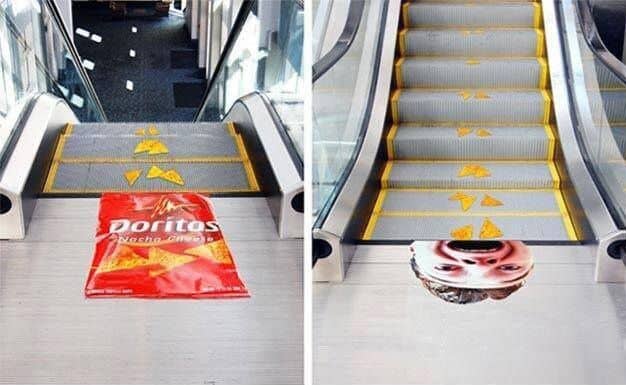
Key Elements of Guerrilla Marketing
Whether you create a flash mob or an unforgettable outdoor experience, some common elements of guerrilla marketing remain.
First, guerrilla marketing is cost-effective. This strategy is meant to create a buzz without spending a lot.
The second factor is authenticity. Your tactic has to align with your brand narrative and values while being unique and out of the box.
Third, it’s meant to be memorable. The creativity of your campaign must evoke interest and curiosity and ignite a conversation around your brand.
Finally, guerrilla marketing can only succeed with the right timing and execution. You only get one shot to execute it flawlessly at the perfect time.
What Types of Guerrilla Marketing Work for Small Businesses?
There are several types of proven and successful guerrilla marketing. The one you choose depends on the goal of your strategy and striking at the right opportunity.
Indoor and outdoor ambient guerrilla marketing
As the names suggest, both these guerrilla marketing strategies are deployed in public places, either indoors or outdoors. Indoor campaigns can happen in malls, subway stations, offices, or airports.
Frontline — a flea and tick spray company — created a buzz in Jakarta with their giant floor sticker that turned humans into an interactive element of their guerrilla marketing campaign.
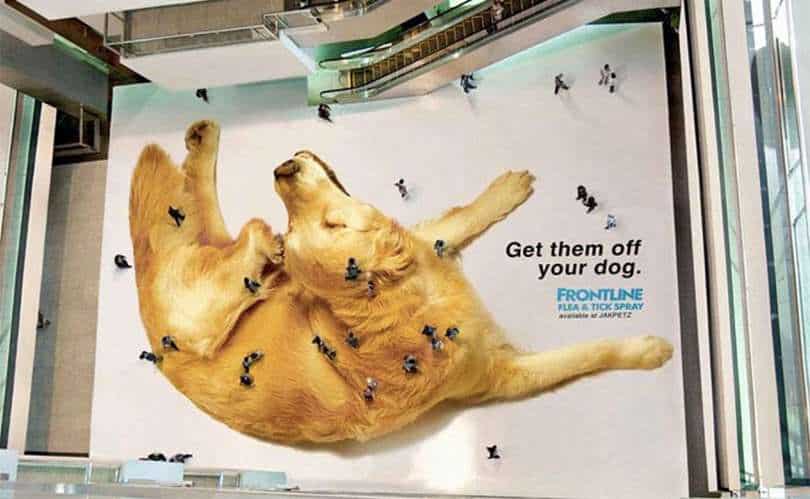
On the other hand, outdoor campaigns can be run on billboards, trucks, streets, parks, and more. Outdoor guerrilla marketing is very versatile and only limited by your creativity.
Ikea got it right when it transformed bus stations in Perth, Australia, into living rooms where travelers could put their feet up and relax to launch their 2018 furniture catalog.

Ambush guerrilla marketing
Ambush guerrilla marketing targets pre-planned events like concerts, sporting events, or festivals. The key is to get the audience to engage with your message or participate in a promotional action. You’re trying to capitalize on a gathered crowd without signing an expensive sponsorship deal to be there.
Pringles distributed around 24,000 crisps cans to hungry Wimbledon fans with the caption, “These are NOT tennis balls.” They even got a Roger Federer and Bjorn Borg lookalikes to grab more eyeballs for the campaign.
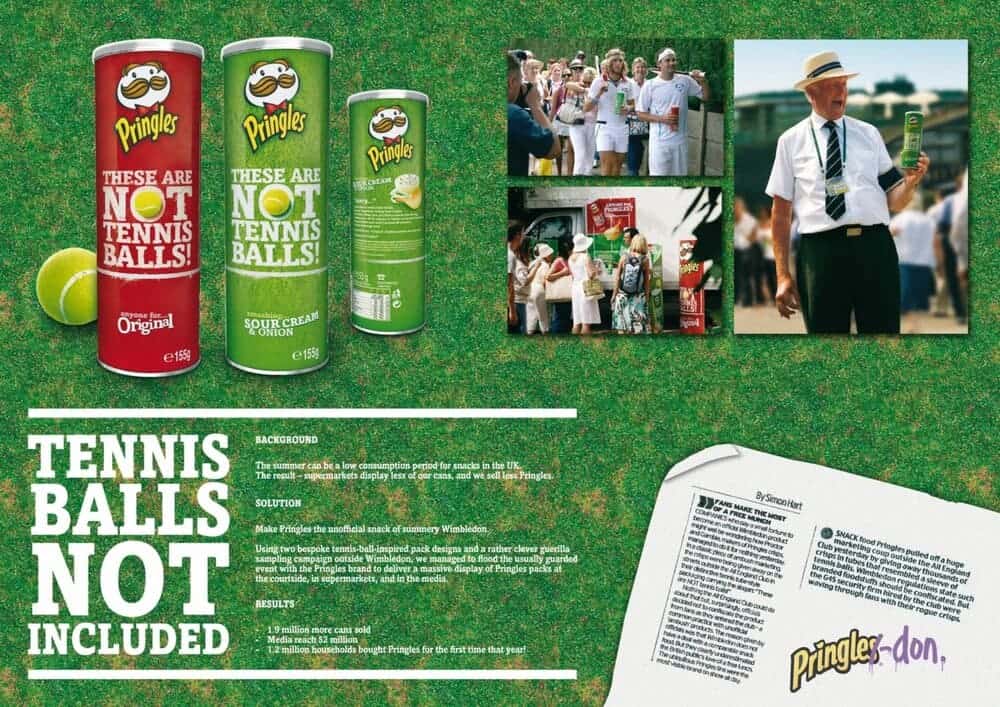
It was such a grand success that even Wimbledon officials didn’t confiscate the Pringles boxes. A caveat about ambush marketing, though — get clear on the fine print of the existing sponsors to avoid spending on legal fees if there’s a clash.
Experiential guerrilla marketing
Interactive or experiential guerrilla marketing involves creating an environment where people interact with or talk about your brand. This could include pop-up events, street art, or a “takeover” of a space with prior permission.
Paramount used experiential marketing to promote ticket sales for Smile, a horror movie. They got actors to pose among the audience at several Major League Basketball games. Even people who had no interest in the horror genre heard about the movie as the campaign went viral on social media.
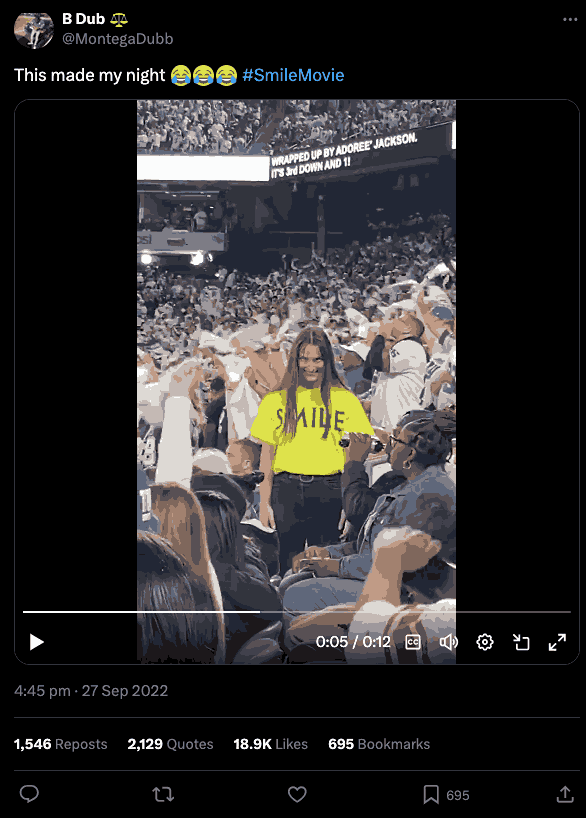
5 Guerrilla Marketing Examples to Inspire You
Several guerrilla marketing strategies were so memorable that people talked about them even a decade later. Here are some real-life examples from brands who killed it for your inspiration.
1. Red Bull Stratos Jump
The Red Bull Stratos jump was such a successful guerrilla marketing campaign that it left an indelible imprint in the audience’s minds.
Known for its extreme sports sponsorships, Red Bull took it one step further in 2012 by sponsoring the highest freefall jump ever attempted in human history.
Felix Baumgartner ascended 24 miles above the stratosphere to successfully execute a free fall that would test the limits of human capacity and our scientific expertise.
Why it was impactful
This was an impressive campaign as Red Bull leveraged the power of digital marketing to livestream the jump on YouTube, garnering over 8 million viewers during the live stream.
The use of hashtags allowed them to connect with excited fans all over the world as the campaign went viral. It also built up Red Bull’s brand reputation well into the future as they continued to sponsor extreme sports.
2. KitKat’s Breaker Bench Campaign
Pedestrians and walkers were in for a surprise in Amsterdam, Utrecht, and Manila — they found park benches delightfully designed as the iconic KitKat chocolate bar. In 2014, KitKat launched a memorable outdoor guerrilla marketing campaign with several variations across different countries.
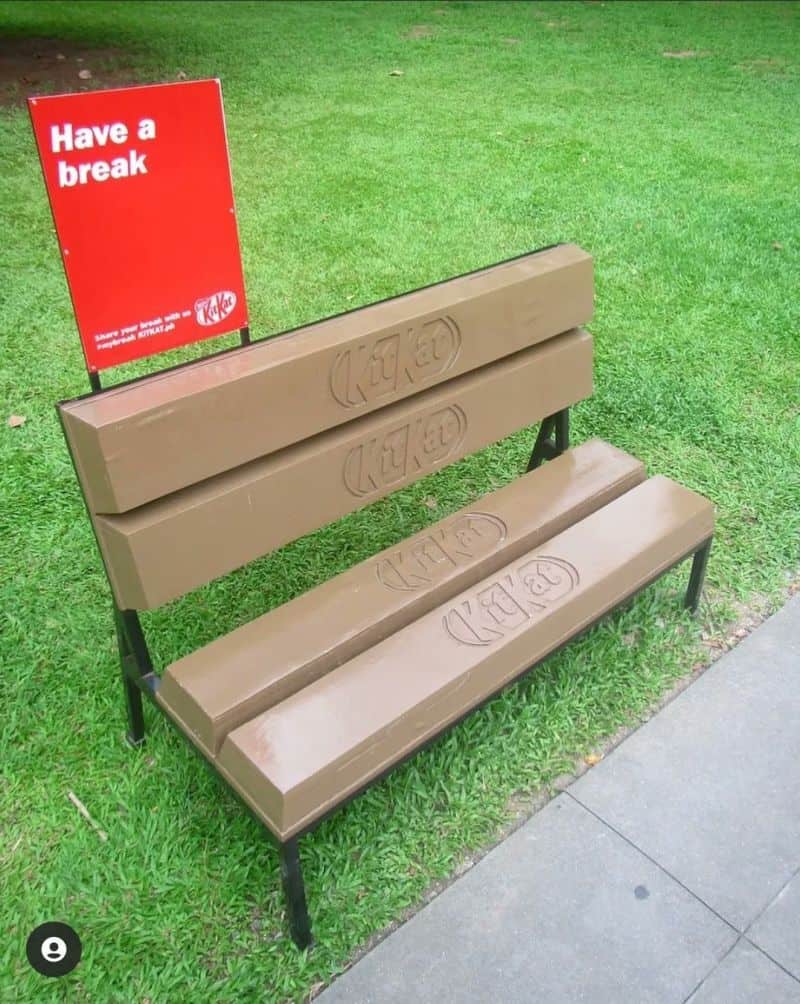
First, they launched a contest where people who sat the longest on their park benches would win a free tablet. This was a huge hit.
In 2016, they launched another Breaker Bench campaign in the Philippines, where they strategically placed variations like a seesaw bench, a piano keys bench, and even a bench on top of a rock climbing wall!

Why it was impactful
The campaign was a hit as it aligned perfectly with what consumers said they loved about KitKat — the look, the texture, and the sound of the wafers breaking.
It generated a buzz among consumers as shared posts and videos from the benches, generating over 262 million impressions on social channels.
3. Jolie Skin Co’s Dirty Truck Campaign
Jolie’s Skin Co. was founded on the premise that water quality in our showers is responsible for most skin and health issues like acne, hair loss, etc. Their filtered showerheads promise to cleanse out harmful heavy metals, chlorine, and other irritants from water.
They wanted to position their shower head as not just another plumbing feature but as a must-have beauty product for health-conscious youngsters.
And they found a beautiful way to translate this idea into action with a stunning guerrilla marketing strategy. They launched an advertisement on trucks around New York City and offered free products to the first customers who could spot them.
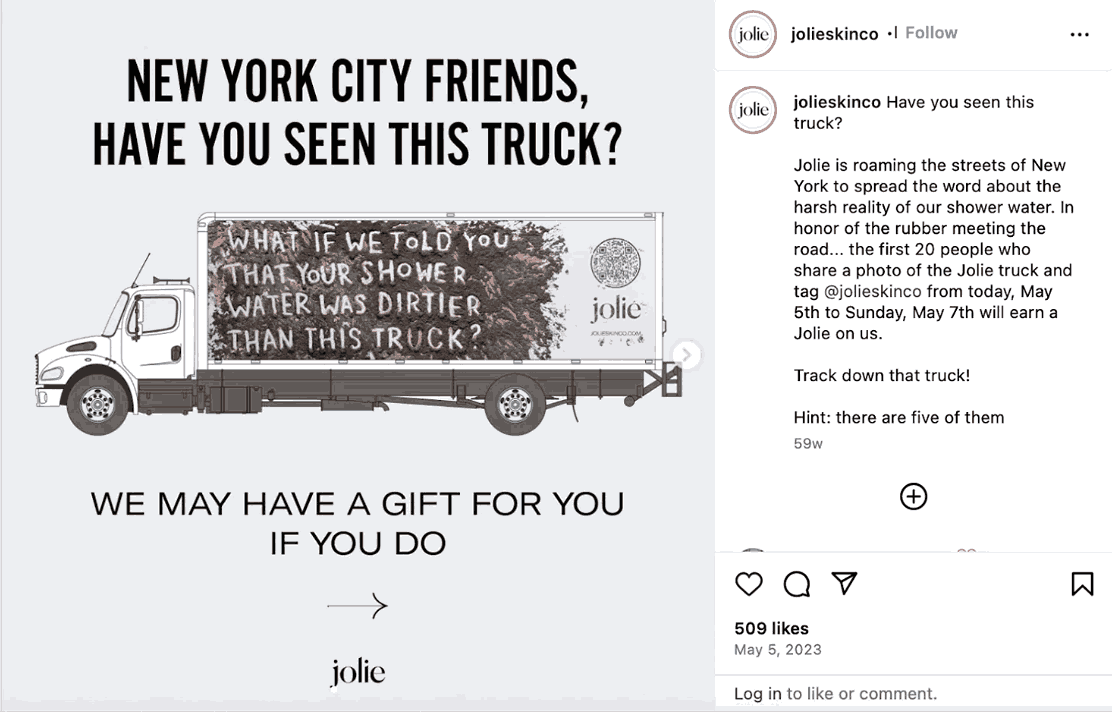
Why it was impactful
The dirty truck ads attracted much attention from customers and the general public. The message “Your shower water could be dirtier than this truck” got a lot of people discussing their products online. Their founder, Arjan Singh, says word of mouth was one of their primary marketing strategies. And this guerrilla marketing campaign achieved that.
The company raised $28 million in revenue in 2023 and gained over 25,000 pieces of user-generated content. They also have over 200k followers across Instagram and TikTok due to their creative marketing efforts.
4. IT Movie’s Pennywise Balloon Campaign
A few days before the release of the horror movie IT, based on Stephen King’s novel — a sneaky guerrilla marketing strategy both spooked out audiences and enticed them.
Across cities in the US and Australia, several red balloons mysteriously appeared above drainage grates with creepy messages like “It’s closer than you think.” Pennywise is often seen carrying a red balloon in the movie.
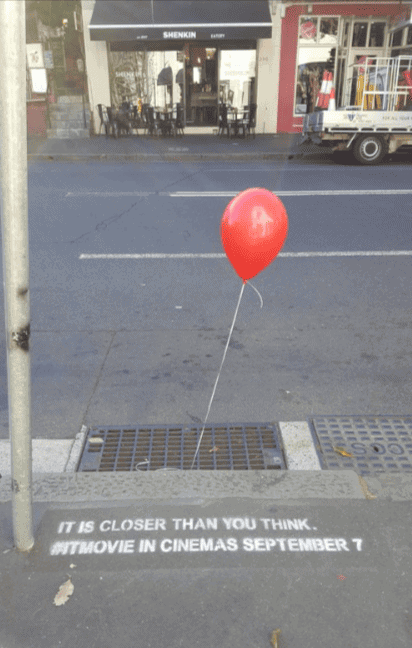
Why it was impactful
The marketers for the film also tied in the stencil messages with hashtags to get the conversation started on social media and generated a buzz. Some users raised concerns about environmental damage caused by the balloons, which the team quickly resolved.
The campaign generated a lot of buzz from different segments of society and started lively online conversations from even the most unlikely of sources.
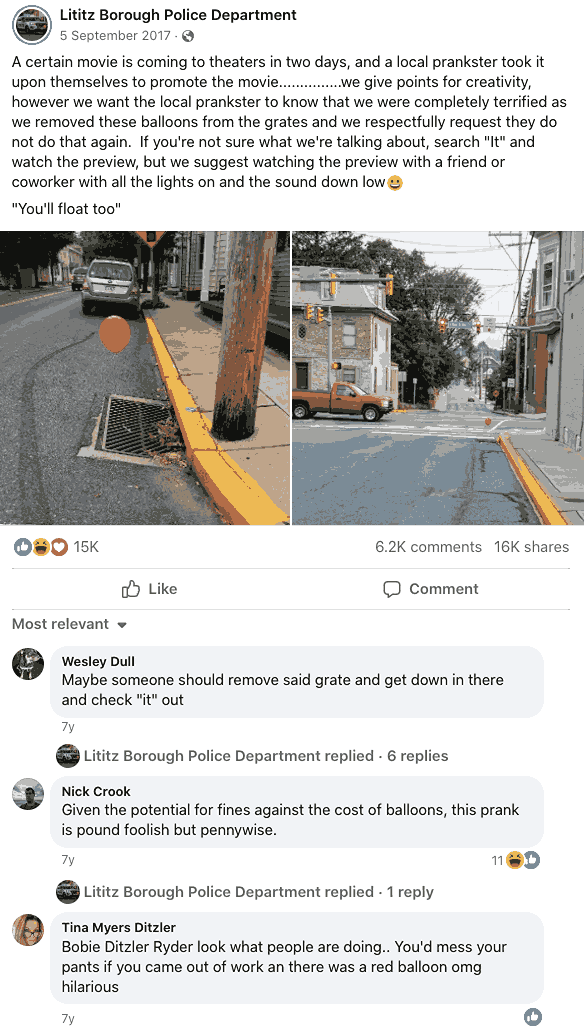
It was an extremely cost-effective campaign and was not too difficult or disruptive to execute. The company also painted several murals, but they generated less buzz than the balloon campaign.
5. Ketchup Campaign Against Landmines
This guerrilla marketing campaign inspired shock and raised awareness about a cause simultaneously by counting on the discomfort and shock it would create among the target audience. The campaign won awards for its innovation and commitment to the cause.
In 2007, Campaign Against Landmines (CALM) sent ketchup packet inserts in leading magazines across New Zealand.
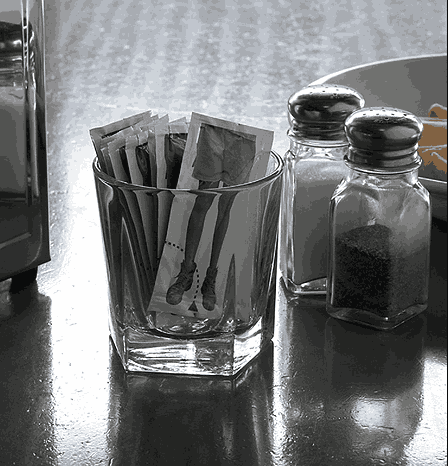
However, it featured a twist. When customers open a ketchup sachet, it will highlight how walking across landmines still causes severe injuries to people in over 89 countries. It made users uncomfortable and encouraged them to donate to solve the problem.
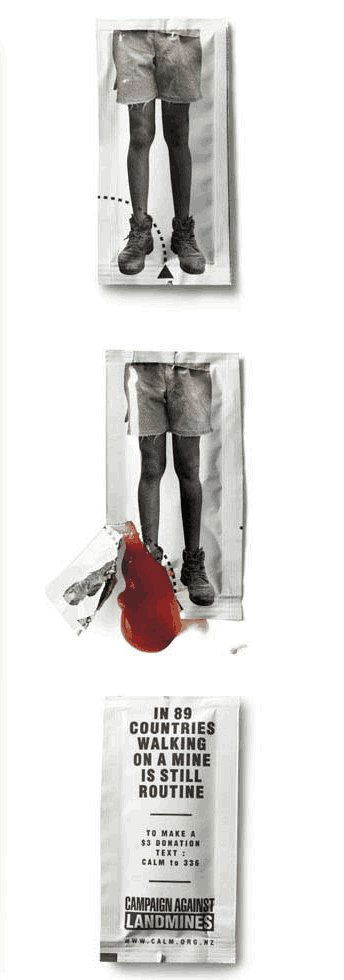
Why it was impactful
The campaign won several awards for raising awareness about landmines. It generated a buzz online as several users also criticized the campaign for trivializing the issue with ketchup sachets.
However, the organizers maintain that it was one way to bring attention to the issue and evoke a sense of fear. The marketer remarked, “Using a ketchup sachet, we demonstrated the horrific nature of living in a land mine-affected country and how much a part of everyday life that horror is.”
Read More: Experiential Marketing Ideas for ‘Next Level’ Brand Campaigns
Tips to Brainstorm and Implement Your Own Guerrilla Campaign
Are you ready to think out of the box and start with your own cost-effective guerrilla marketing campaign? Here are our top tips to get you safely from the brainstorming phase to the implementation phase.
Set clear objectives and understand your target audience
The first step is to research your target audience and competitors thoroughly. What do your customers love the most about your products? What makes you unique and stand out from your competitors?
Whether you create a memorable experience or a simple stencil decoration on the street, your campaign should tie in with your brand values and USP.
Figure out exactly what your target audience values. What are their interests and motivations? What kind of conversations will likely hold their interest and generate a buzz? These questions will help you tailor your campaign and create a cohesive strategy.
Get creative and encourage teamwork
The next step is to brainstorm ideas for your campaign. Encourage all team members to contribute and emphasize that no idea is too stupid. Often, a rudimentary idea can be improved by the collective skills of your team.
Focus on ideas that impart a sense of novelty, surprise, humor, interactivity, or even satire. Finally, consider how you will implement your idea. Could it be just some simple posts on social media, or do you need to implement it in real life?
Align your campaign and goals to your brand image
This step is indispensable to the eventual success of your campaign. There’s a fine line between a novel, unique idea, and an idea perceived as improper or inappropriate. Notice how even in the successful campaigns we listed in the examples, users still had concerns over the ethics and environmental impact of the campaigns.
An idea gone wrong can severely damage your brand image and have the opposite effect. Test your ideas on a small group of your target audience before launching it for the wider public. The key is to get a sense of the “perceived interaction” from your audience.
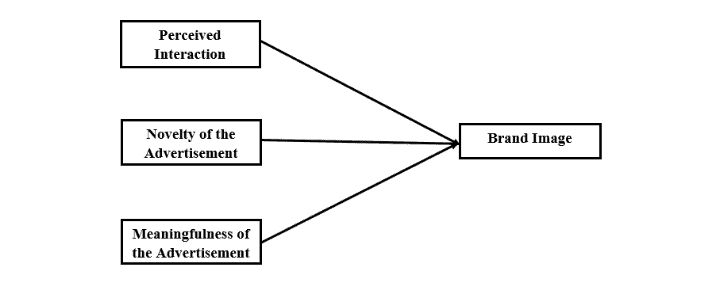
Collaborate with local businesses and leverage PR opportunities
A collaboration with a complementary business could prove lucrative for both your brands. However, ensure that your partner brands align with your company values and each of you adds mutual benefits to each other. Leverage any PR opportunities and have well-written write-ups ready for release well before the launch of your campaign.
For example, in the KitKat bench campaign, the chocolate brand partnered with Nexus 7 to offer a tablet giveaway for customers who sat longest on the bench. The Nexus 7 tablet operating system was named KitKat, giving visibility to both brands through the campaign. Even an unlikely pairing like a chocolate brand and a tech brand could reap a world of benefits for both.
Read More: 14 Creative Customer Engagement Strategies for Small Businesses
Common Pitfalls to Avoid (with Failed Guerrilla Marketing Examples)
A guerrilla marketing strategy is memorable and gets people talking about your brand. But it is not without risks. The same memorability could work against you if something goes wrong and hamper your brand image. Here are some common pitfalls and how you can avoid them.
Lack of clarity in messaging and lack of alignment with brand values
The most common risk with guerrilla marketing tactics is misunderstanding your messaging. As it relies on the element of surprise or awe, even if your messaging is slightly off, it can have potentially disastrous consequences.
For example, a Fiat campaign went horribly wrong in Spain back in 1994. Fiat sent their target audience a series of love letters over several days.
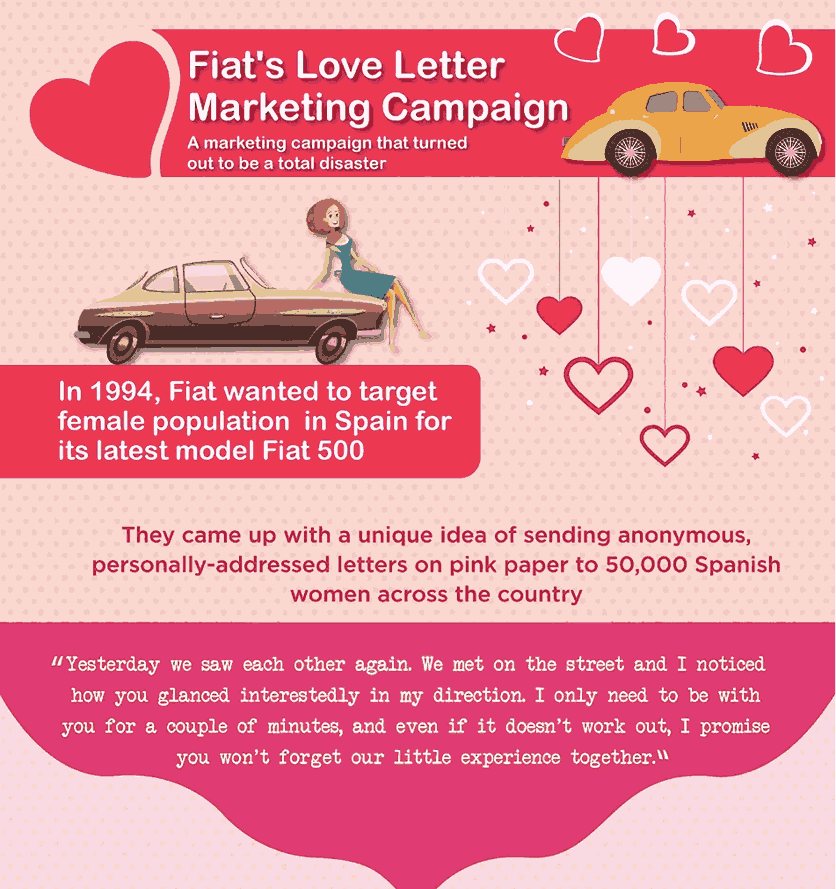
This resulted in several unintended consequences. Some women were terrified about being stalked and locked themselves for days in their apartments. It unintentionally caused rifts between married couples, and several women reported the letter to the police.
After four days, Fiat sent out a clarification letter with the company logo, a brochure, and an invitation to the nearest Fiat showroom. But by then, the damage was already done. Instead of evoking curiosity, engagement, and romanticism, the campaign backfired. Perhaps a logo or a promotional code in the first letter could have prevented this.
The company was asked to pay some fines in damages and apologize for the stunt.
Failing to get permits and other legal or ethical issues
Before launching your campaign, do your due diligence to consider legal and ethical considerations. Get the required permits and research the local culture to avoid any misinterpretations.
A famous example of a strategy gone wrong is Cartoon Network’s 2007 promotion in Boston. The company put up small glowing devices around the city that displayed a character from its new series.
However, it backfired as scared audiences called the cops, fearing a bomb threat. Several roads and bridges were shut down, and bomb squads were deployed to keep citizens safe. The company was fined $2 million for this campaign!

So, make sure to read the local and national guidelines. Inform police departments and other officials in advance if possible. Always get the required permits before launching your campaign.
Underestimating audience reactions
Always anticipate some negative responses, especially if your ideas are novel and innovative. However, consider audience reactions and have a backup plan ready, too.
Here’s an example of Sony’s Playstation campaign gone wrong. Sony had the required permission from building owners to graffiti their walls to promote their new PlayStation Portable in 2005. However, the campaign ended up being extremely polarizing.
Several people accused Sony of trying to downplay the recent issue of Sony CDs infecting several computers with malware. There was a backlash as several graffiti sites were painted over by angry locals to send a message to Sony.
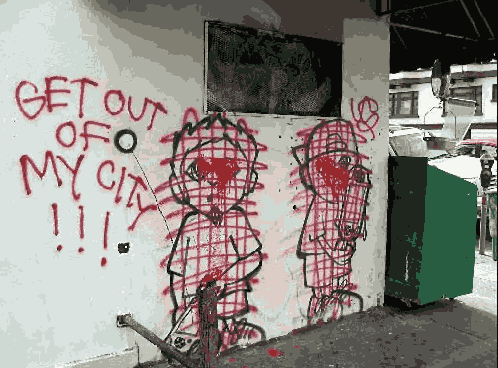
How to Measure the Success of Your Guerrilla Campaigns
Now that you can brainstorm and launch your guerrilla marketing campaign, how do you measure the success of your campaign? Here are some tips and KPIs to measure your results and iterate your process.
Evaluate KPIs that align with objectives
You’ve set your objectives for your marketing campaign at the outset, right? The KPIs you choose will depend on your objectives to a great extent. For example, if your goal included generating more sales, KPIs would include customer acquisition costs and cross-sell or up-sell value.
Engagement rates
This is one of the most significant criteria, especially when leveraging the power of social media. Measure metrics such as likes, shares, reposts, and mentions related to your campaign. Measure the increase in organic traffic to your website and email metrics if you’ve used those channels for your campaign.
Increase in brand awareness
Consider conducting surveys and polls before and after your campaign to measure brand awareness and perception. While measuring engagement and reach can provide information on how often and how much users interacted with your brand, surveys can give you added data points on the perception, impact, and memorability of the event.
Sales growth during and after your campaign
Even if your goal wasn’t to increase sales with your guerrilla marketing campaign, you can measure these metrics to evaluate the impact on your sales and conversions.
For example, even if sales haven’t gone up, there may have been an increase in new users signing up for your newsletter or a rise in people browsing your website during the campaign.
Read More: 16 Powerful Customer Retention Strategies to Prevent Churn
Wrapping Up
Guerrilla marketing is cost-effective, memorable, and interactive. For better or for worse, it’s here to stay. While it brings businesses a world of benefits, it also has some risk due to its novelty and surprise factors.
So, ensure you cover all bases and do your homework thoroughly before embarking on this battle. After all, the increased awareness and word-of-mouth marketing will be worth it.
We hope these ideas, pitfalls, and strategies have helped you on your guerrilla marketing journey. Let us know in the comments which examples resonated the most with you.
EngageBay is an all-in-one marketing, sales, and customer support software for small businesses, startups, and solopreneurs. You get email marketing, marketing automation, landing page and email templates, segmentation and personalization, sales pipelines, live chat, and more.
Sign up for free with EngageBay or book a demo with our experts.
Content updated for SEO and freshness by Krishna Varma.
FAQs
1. How can small businesses benefit from guerrilla marketing?
Small businesses can benefit from guerrilla marketing by generating a buzz around their products without spending much of their marketing budget. Here’s how guerrilla marketing can benefit you:
- Boost brand awareness and visibility
- Help establish your brand personality and values
- Build a genuine connection with your target audience
- It can help differentiate your brand from the competition
- Showcase your creativity with memorable moments to keep you on top of your mind
2. Are there any legal considerations for guerrilla marketing?
Guerrilla marketing is legal. However, you must ensure compliance with consumer protection laws before launching your campaign. We recommend checking with a lawyer to ensure the success of your campaign as well. Here are the top legal considerations for guerrilla marketing:
- Graffiti and trespassing laws
- Avoid deceptive advertisements or claims
- Intellectual property rights
- Public safety
- Permits and permissions
- Social and cultural sensitivity
3. Can guerrilla marketing work for online businesses?
Yes, guerrilla marketing can work for online businesses. Online businesses can consider a mix of online and offline tactics for maximum success.
4. Why is it called guerrilla marketing?
The “guerrilla” in guerrilla marketing comes from the unconventional warfare tactic used to ambush opponents. It typically features atypical techniques and a lean army. The marketing strategy borrows the element of surprise from the war tactic. It was a term coined by Jay Conrad Levinson for marketing tactics that evoke an element of surprise or shock with a lean budget.
5. What are some proven guerrilla marketing tactics for small businesses?
Some proven guerrilla marketing tactics for small businesses include:
- Flash mobs
- Street art or sidewalk chalk art
- Pop-up events
- Social media challenges
- Branded merchandise like pins or lapels
